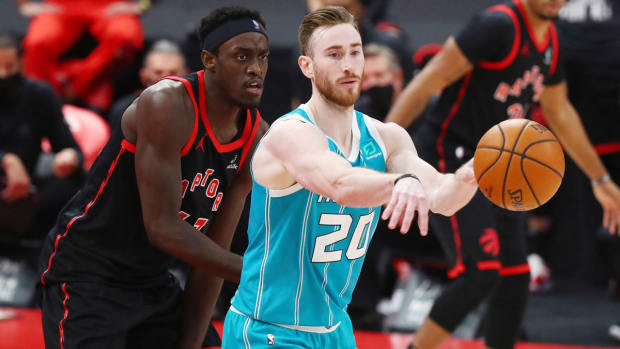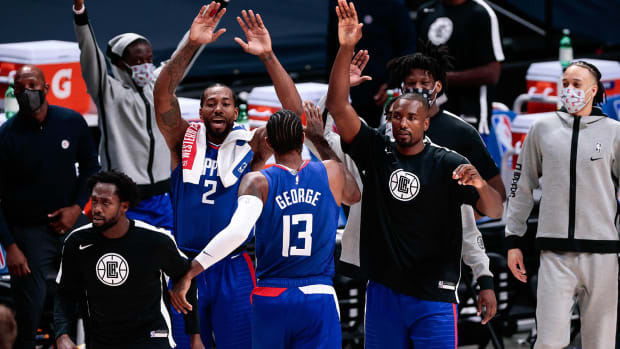Handing out fake hardware just over a quarter of the way through this 2020-21 NBA season.
It’s been a confusing, pressed year in the NBA, with postponed games, positive COVID-19 tests and sporadic lineup changes dictated by the league’s health and safety protocols. Just over a quarter of the way through this 2020–21 season, it’s hard to craft any rock solid takeaways. But to highlight some of what we have seen so far, here are some fake, fun, totally random awards that may or may not hold up over the next several months.
Most Dominant Player: Joel Embiid
Through the 2021 season’s opening six weeks, the gaps between LeBron James, Kawhi Leonard, Nikola Jokic, Kevin Durant, Bradley Beal, Giannis Antetokounmpo, Damian Lillard, Steph Curry, Luka Dončić, and Joel Embiid are small. All are stupendous. But I want to use this space to celebrate Embiid, a big man neck-and-neck for the league’s PER lead with a true shooting percentage that’s exactly what Curry’s was (66.9) during his unanimous MVP season in 2016. In fact, Curry is the only other player in NBA history with a true shooting percentage that high,
plus a usage rate that eclipses 32.A mature, healthy version of the Sixers' All-NBA center—who’s logging more minutes this year while surrounded by players who accentuate his strengths—is powerful enough to reorient the title race. He’s obliterating opponents who aren’t built to deal with someone that large with those skills. Embiid’s ceiling, one can argue, is higher than literally every other player alive. (On a team that’s 14–2 when Embiid plays and 1–4 when he sits, try scanning his game logs without letting your jaw scrape the floor.)
In addition to weighing his impact against several of this season’s brightest performers, it’s useful to compare Embiid’s production with the player he most resembles: How does he stack up against 26-year-old Shaquille O’Neal? Despite several statistical similarities—including usage, rebound rate, assist rate, block rate, two-point field goal percentage, and PER—it’s not really that close. Thanks to his propensity for threes and (30% more) accurate foul shooting, on a per game basis Embiid is way more efficient, averaging two more points than Shaq despite playing three fewer minutes. Embiid’s free-throw rate is higher, too, and his defense is superior.
The sport has evolved dramatically over the past two decades, but exercises like this one can help remind us that as good as Embiid has already been, there’s still plenty of time for him to get better and accomplish more. A year after that lockout-shortened 1999 season, 27-year-old Shaq won his first championship and his only MVP. An even better version of the Embiid we’re currently watching could easily follow that same track. In the meantime, he’s been an absolute wrecking ball.

Most Impactful Free Agent Signing: Gordon Hayward
On a recent episode of the Open Floor podcast, a listener emailed to ask what award the NBA should name after LeBron James once his career ends approximately 15 years from today. To answer, I came up with a brand new honor: best free agent signing! What better way to honor a player who used free agency to shake up the league’s power dynamics while simultaneously altering its entire landscape? LeBron’s on-court legacy is massive, but his will to spark an empowerment-based revolution may be just as influential.
This year, three players are almost equally deserving of this fictional distinction: Christian Wood, Jerami Grant and Gordon Hayward. Each one has a valid case, and if contract value is included the answer has to be Wood, whose $41 million deal is $79 million less than Hayward was guaranteed by the Hornets and $19 million less than Grant took from Detroit.
All things even, though, I’m going with Hayward, who has one fewer point than Kawhi freaking Leonard and looks exactly like the player Boston expected three years ago. This season feels like what his first season after he left the Jazz should’ve been. He’s averaging a career-best 23.2 points with a career-high 61.3 true shooting percentage. His usage is more than five points higher than it was in Boston.
While still crafty out of the pick-and-roll—there’s no speeding him up or slowing him down—and more comfortable/useful off the ball than most players who just signed a $120 million contract, Hayward finally has that burst he spent the past few years trying to find through rehab and a relentless string of medical procedures.
Charlotte would be in trouble going small as often as it does if it weren’t for him looking like his former self. Hayward is a key reason lineups with PJ Washington or Miles Bridges at the five are singing, and even though the Hornets aren’t built to win a playoff series this season, they’d probably be the worst team in the East without him.

Most Dangerous Lineup That Doesn’t Actually Play: Kawhi Leonard, Paul George, Nicolas Batum, Serge Ibaka, Marcus Morris Sr.
Why can I not stop daydreaming about this group? It’s everything a modern five-man unit should ask for: At all five positions there’s [takes deep breath] shooting, size, willing-to-elite passers, and an isolation/post-up threat. There’s pick-and-roll playmaking, rebounders, versatile defenders, rim protection ... I can go on and on.
Patrick Beverley, Luke Kennard, Lou Williams, Ivica Zubac, and every other member of the Clippers' rotation matters if they want to win a title. But when their season is on the line in the final minutes of a tight playoff game, this is the group Ty Lue absolutely should have on the floor. On paper, across the entire league, it might be the closest we get to a team able to take advantage of positionless basketball without seeing any severe drawbacks on either side of the court.
Lue has only broken it out once this season, late in the fourth quarter of a win against the Thunder. Nothing significant can be gleaned from such a quick stretch but it was immediately clear just how endless their possibilities on offense can be. Plug one hole and another immediately appears.
And even more importantly, when deployed in a postseason hot house their defense has no obvious weak link. This group can switch most screens, but doesn't necessarily need to, either, which is a nice place to be. There’s so much length and awareness on the floor.
Hopefully we’ll get a larger sample size later this season. Regardless, in the spring nobody will want to face this group.
All-Around Strangest Development: Andrew Wiggins becoming mini Mutombo
Andrew Wiggins’s career block rate on the Timberwolves was 1.4. This year it’s 4.1. That’s more than Embiid, Giannis, Bam Adebayo and pretty much every other non-center in the league. This is ridiculous. And the coolest thing about all these blocks is how they happen: Wiggins isn’t just not giving up on plays—several blocks have been against jumpers when he trails over a screen without fouling—he’s baiting layups into existence, like a free safety who wants the quarterback to believe his receiver is wide open. Ballhandlers who beat him off the bounce and then convince themselves they have a clear runway to the rim should probably stop thinking that.
Wiggins has slapped well over half off the glass, often starting a fast break the other way. Functionally, it’s a Bill Russell–esque jolt to the rhythm of the game that is hard not to enjoy. The Warriors certainly do.
Breakout Sidekick: De’Andre Hunter
Before he “underwent a non-surgical procedure to address articular wear and tear in his right knee” over the weekend, Hunter was quickly turning into one of the game’s most promising two-way wings. His in-between game has really popped, with a two-point percentage that’s rocketed up from 45.4% as a rookie to 60.9% today.
Hunter has shown growth everywhere, particularly when Trae Young is not on the court, and Hawks coach Lloyd Pierce has responded by designing after-timeout plays that put the ball in his hands in positions to succeed, in the mid post or just off on the wing. Simple actions that let Hunter make decisions.
With so many injuries endured during the season’s opening month, Hunter’s production was an answered prayer. But over the long-term, arguably the most meaningful development is how confident he looks attacking defenses that switch Young’s ball screens. It hasn’t happened too often, but against the Nets—a team that helplessly switches everything because they can’t execute much else—it was good to see Hunter do what he’s supposed to against a Kyrie Irving mismatch.
Hunter didn’t look like he’d ever sniff All-Star weekend as a rookie. Now there may be an appearance or two in his future (knee willing).
Sunniest Bounce Back: Mike Conley
The most heartwarming plot point from a season that doesn’t have much room for that sort of thing is 33-year-old Mike Conley suddenly looking like he’s 27. Give him all the roses and all the All-Star votes. He’s averaging career per-36-minute highs in assists and rebounds with the most win shares per 48 minutes he’s ever logged.
On top of that, Conley has become the tip of the spear for a team that currently embraces the three-point line more than any other. (RIP to Daryl Morey’s Rockets, who wore that belt for the past seven seasons.) He’s always been pretty good from deep, but never quite like now, when well over half of his shots are threes, nearly a third are off the dribble and more than 40% are going in. The volume is up but so is the accuracy, a trend that helps explain Utah’s 11-game winning streak. (The Jazz were +34 with Conley on the court during their first 10 games and are +207 since.)
His fantastic on/off numbers benefit from a defense that’s enjoyed some good luck against opposing three-point shooters—they’re almost 8% more accurate when Conley does not play—but all in all it’s never bad to have the eighth-best real plus-minus rating in the league. His pick-and-roll chemistry with Rudy Gobert is sublime, too. Can we please send this man to the All-Star game?
Most Concerning Start (That Actually Matters): Josh Richardson
It’s been a tough season for the Mavericks, in part because Josh Richardson has had a tough start. Dallas acquired him for two reasons: 1) defense, 2) he’s three years closer to Luka Dončić’s timeline than Seth Curry was. But, theoretically, Richardson could diversify Dallas’s offense, too.
Ideally, the Mavs would utilize him in myriad ways that stretch beyond your typical spot-up shooter who reacts off Dončić’s genius. Richardson has shown he can make plays in addition to finishing them. Instead, so far it’s almost like the Mavs bought a 70-inch flatscreen to light up a room.
Partially thanks to a severe downturn in chances to create out of the pick-and-roll, Richardson currently has the worst assist rate of his entire career—7.2 %, almost exactly half what it was during those four years with the Heat—and it barely rises when he plays without Dončić.
Richardson hasn’t made a three since returning from a 20-day, nine-game absence due to the league’s health and safety protocols, and is down to 28.1% on 57 attempts on the season. He’s a better shooter than this, but maybe shift a little bit more responsibility his way and see if it helps accelerate the ride back to normal. Richardson’s average seconds per touch is one tick below his last season with Miami. Average dribbles per touch are way down, too.
It’s early. And Richardson has barely had any time on the court with Dončić and Kristaps Porzingis. But if he continues on as a one-dimensional offensive player, shooting slumps will matter more than they should. Let J-Rich cook.


0 Comments